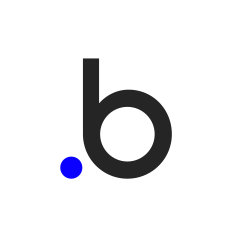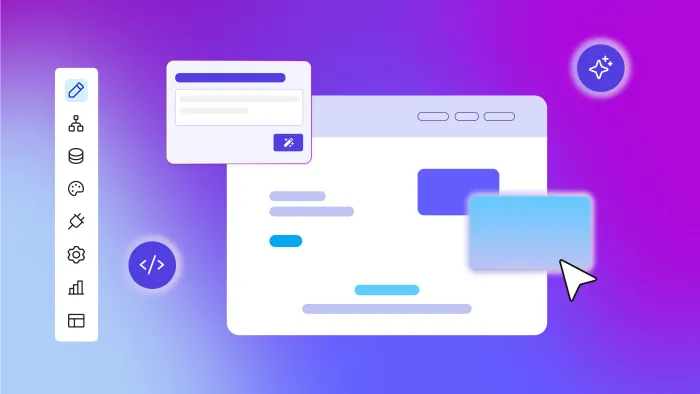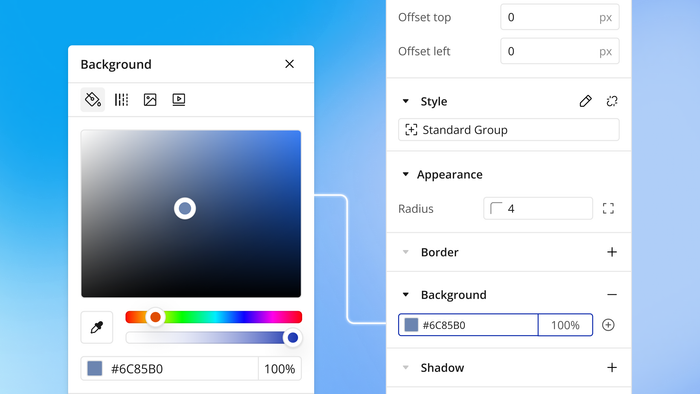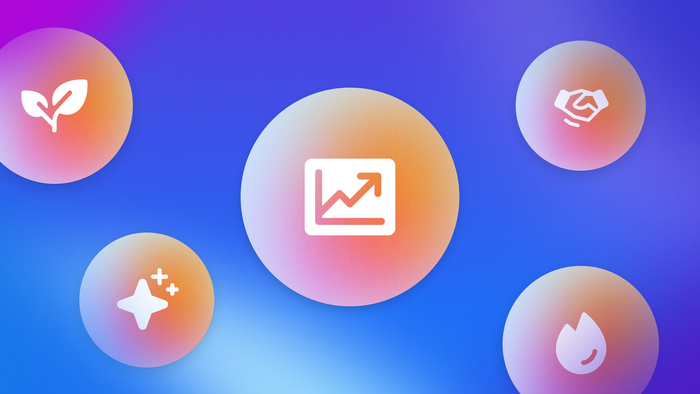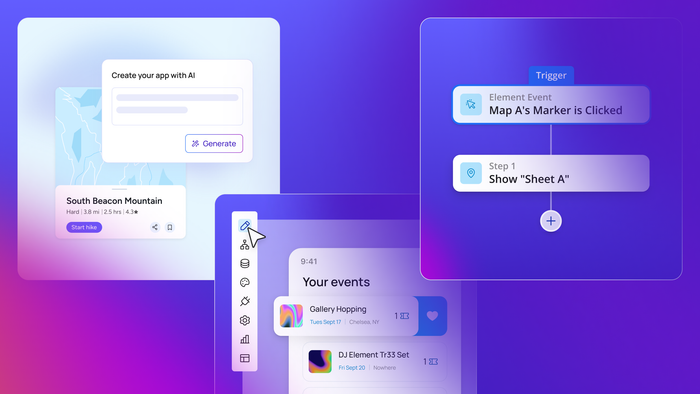Executive summary
Throughout 2024, AI-powered code generation tools captured headlines with promises of instant app creation through simple prompts. As a platform that’s been empowering builders for over a decade, we wanted to move beyond the hype and understand what’s actually working for people building production applications.
We surveyed 793 current and former Bubble builders — people who’ve explored both visual development and vibe coding tools — about success rates, productivity, security, and the future of AI app building. This audience is a strength, not a limitation. These builders have real experience shipping applications, freedom to explore any tools they want, and direct comparison points between approaches. Many actively use multiple platforms. When builders who could choose any approach tell us what works for production applications, that provides valuable insight into where the industry stands.
The findings reveal decisive patterns. The confidence gap between approaches is substantial: 71.5% of builders feel confident using visual development for mission-critical applications, compared to just 32.5% for vibe coding. In practice, only 9% actually deploy vibe coding tools for business-critical applications, while 65.2% use visual development for the majority of their production apps.
Security concerns create hesitation around newer approaches. 72.3% of builders worry about security vulnerabilities in vibe coding platforms. Meanwhile, 52.8% rate visual development as the most secure approach — more than traditional coding (22.7%) or vibe coding (12.6%).
When it comes to recommendations, the numbers tell a clear story. 86.7% would recommend visual development to new entrepreneurs, compared to 51.4% for vibe coding. Success rates prove accessibility works: 87.6% of respondents successfully completed projects they couldn’t have built otherwise, with 77% of complete beginners succeeding using visual development tools.
The business impact is measurable. Nearly 50% of builders saved between $10,000 and $250,000 annually in development costs using visual development tools, with 84.9% reporting a reduced need to hire engineers.
Our prediction for 2025: Visual development platforms integrating AI capabilities will dominate production application development, while prompt-only vibe coding tools will remain valuable for prototyping but struggle when builders need to debug, customize, and maintain applications over time.
Introduction: A year of AI hype meets reality
The 2024 narrative was compelling: “Anyone can build apps now — just describe what you want.” AI code generation tools like Lovable, V0, Replit Agent, and Claude Artifacts promised to democratize software development through natural language prompts. The excitement was genuine, the demos were impressive, and the possibility of instant app creation captured imaginations across the industry.
But a year into this AI app-building revolution, we wanted to know: What’s actually working — and what’s not?
As a platform that’s been empowering builders for over a decade with visual development, we weren’t interested in defending territory. We wanted real data about what delivers for builders when they need to ship production applications. Our community provided a unique perspective: they use visual development daily, and many have actively explored vibe coding tools. These are builders who’ve tested both technologies and can compare them based on real experience.
About our survey audience
We surveyed 793 current and former Bubble builders — a community that includes professional developers (22.7%) who bring traditional coding experience, founders building their own companies (36.4%) with real businesses on the line, non-technical business users (22%) proving accessibility isn’t just theory, and complete beginners (14.3%) testing whether these tools truly democratize development.
Most importantly, this community has had the freedom and technical curiosity to explore vibe coding tools. In fact, 25.6% report actively using vibe coding platforms alongside visual development. These aren’t people locked into one approach — they’re builders who’ve tested both technologies based on a genuine interest in finding the best tools for their needs.
The central questions
When you’ve tried both approaches, which delivers production-ready applications? Where does each technology excel — and where does it fall short? What do experienced builders recommend to new entrepreneurs?
The results reveal a clear pattern: Visual development holds its lead when it comes to builder confidence, security reliability, and the ability to ship production applications. Here’s what we found.
About this research
We collected 793 responses between September and October 2025 from current and former Bubble users, including active users from the last 30 days, users who generated apps with AI, professional agency builders, and long-time users exploring other options.
Why this audience matters
We surveyed our own community — and that’s a strength, not a limitation. These builders have real experience shipping applications, not just experimenting. They have the freedom to explore any tool they want, and many actively use multiple platforms. They possess technical knowledge ranging from beginners to professional developers, giving them the ability to evaluate capabilities meaningfully. Most importantly, 25.6% actively use vibe coding tools, providing direct comparison points between approaches.
This isn’t a neutral industry survey — it’s something potentially more valuable: experienced builders reporting on what actually works when you need to ship production applications.
Clear definitions
For this research, we defined visual development platforms as drag-and-drop builders with visual logic and workflows like Bubble, Retool, and Webflow. These platforms let you see and edit how your app works through visual interfaces rather than code.
Vibe coding tools are AI-powered code generation via natural language prompts, including platforms like Lovable, V0, Replit Agent, and Claude Artifacts. These platforms generate applications through conversational AI, outputting code that may or may not be easily editable.
The hybrid approach represents platforms combining AI generation with visual editing capabilities, offering both speed and control.
What this research can and cannot tell us
This research reveals how experienced builders evaluate both approaches, success rates and confidence levels among people actually shipping apps, where each technology excels and where it struggles, and real-world productivity gains and business impact.
However, it cannot provide absolute market share across all builders globally, experiences of pure vibe coding users who have never tried visual development, or theoretical capabilities unconstrained by real-world usage. What it offers instead is insight grounded in production experience — builders who’ve shipped real applications comparing what actually works versus what’s promised in marketing materials.
The state of builder adoption and success
Who’s building and how
The visual development community represents a remarkably diverse spectrum of builders. Among professional roles, founders make up 36.4% of respondents, followed by developers at 31%, business owners at 10.9%, and freelancers or consultants at 8.7%.
The technical background distribution is equally broad. Professional developers make up 22.7% of the community, while 23.9% have some coding experience and 22% are non-technical business users. Another 17.1% have technical backgrounds, though it’s not their primary role, and 14.3% are complete beginners.
Visual development isn’t just for non-technical founders. Professional developers choose these platforms for the same reason everyone else does: They deliver results faster. The presence of complete beginners alongside professional developers in the same community demonstrates that these tools genuinely serve builders across the entire spectrum of technical ability.
In terms of organization size, the majority operate as solo founders or freelancers (53.2%), while startups and small businesses with 2-200 employees make up 42.5%. Mid-size and larger organizations represent less than 5% combined. When it comes to primary use, 54.9% are building their own product or company, 27.3% are building for other businesses, and 9.6% work on personal projects.
Platform usage patterns
Tool preferences reveal clear adoption patterns. While 90.6% use visual development platforms, only 25.6% use vibe coding tools. These aren’t casual experiments — usage frequency shows that 63.2% use these tools daily and another 28.2% use them weekly. Combined, over 70% use these tools multiple times per week or more.
Experience levels span from newcomers to veterans. About a quarter (25.1%) have less than six months of experience, while another quarter (24.9%) have been using these tools for two to five years. The distribution shows 17.6% with six to twelve months experience, 18.8% with one to two years, and 13.6% with more than five years.
The 25.6% using vibe coding tools represent meaningful experimentation — our community isn’t afraid to explore new approaches. But the 90.6% using visual development daily or weekly reveals where builders land when they need to ship production applications. This isn’t a theoretical preference; it’s what people rely on when their business depends on it.
Success rates across all skill levels
The most important finding: 87.6% successfully completed projects they couldn’t have built otherwise. Breaking this down, 50.6% completed multiple complex projects they never could have coded themselves, 23.9% completed a few projects beyond their technical abilities, and 13.1% completed mainly simple but valuable projects. Only 9.4% haven’t been successful yet.
Success by technical background reveals true accessibility. Complete beginners saw a 77% success rate, while 83.2% of non-technical business users actively use visual development tools. Even professional developers — people who can code traditionally — report that 86% completed projects they couldn’t have built otherwise.
The narrative around AI app building often focuses on making development accessible to non-technical founders. What’s remarkable is that even professional developers report that visual development platforms let them build things they couldn’t have otherwise. This isn’t about replacing coding ability; it’s about expanding what’s possible.
What “success” means: Real production applications
Survey respondents aren’t building toy apps — they’re shipping real applications across industries. In healthcare, builders created hospital and clinical appointment systems and cancer care journal planners. Transportation applications include car sharing web platforms and travel booking services. Business services span mechanical workshop management SaaS systems, freelancer marketplaces, and church service planning tools.
Real estate applications include condominium management platforms, while e-commerce builders launched wine sales platforms with personalized label creation. Education and training applications range from LMS training platforms to Jiu-Jitsu training journals. Enterprise tools include ESG scoring frameworks, scheduled maintenance applications, and music collaboration platforms.
The range spans healthcare, education, automotive, real estate, entertainment, and enterprise tools — demonstrating that visual development platforms are handling complex, production-grade applications across industries.
Visual development vs. vibe coding: The direct comparison
With 25.6% of our community using vibe coding tools, we have a unique window into how these technologies compare in practice. These aren’t theoretical opinions — these are builders who’ve tested both approaches and can report on where each succeeds and where it falls short.
Builder confidence and mission-critical use
The confidence gap for mission-critical applications is substantial. For visual development, 71.5% of builders feel “very” or “extremely” confident, compared to just 32.5% for vibe coding.
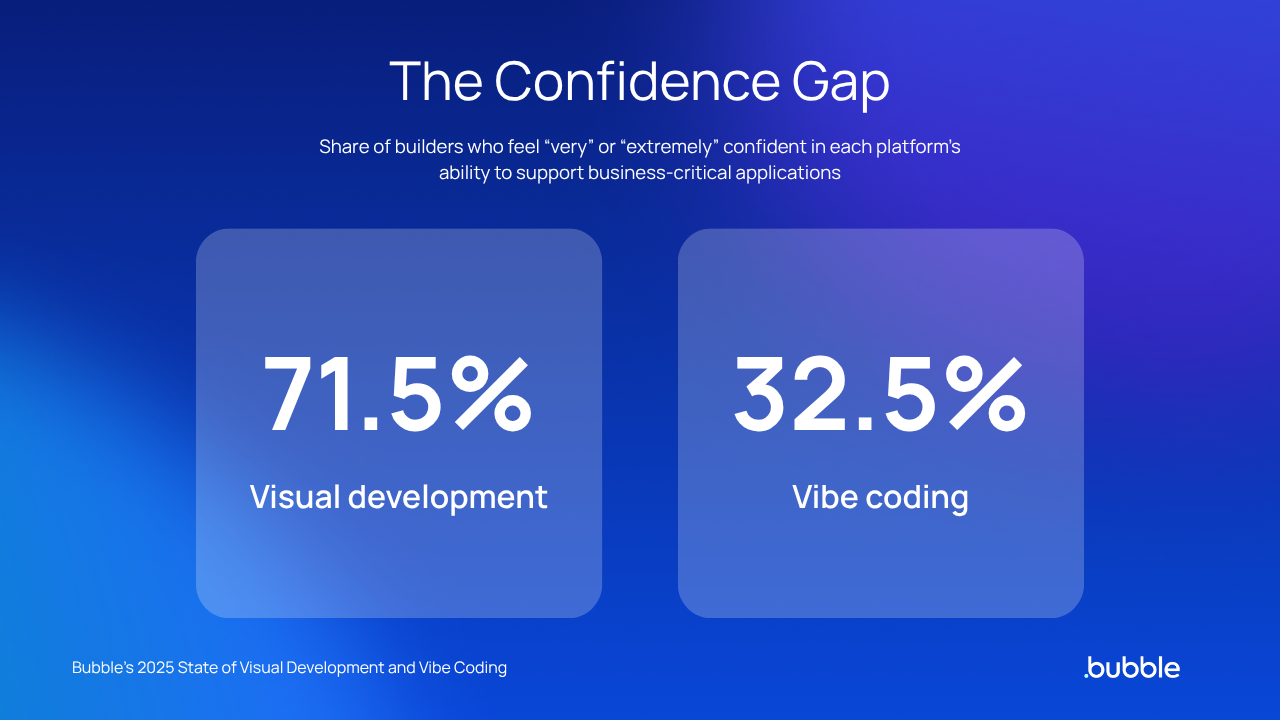
This goes beyond mere sentiment, showing up in what builders actually deploy. When we asked what percentage of their business-critical applications were built using each approach, visual development dominated production use. Nearly half of builders (45.8%) run 76–100% of their business-critical apps on visual platforms, while another 19.4% run 51–75%. Combined, 65.2% use visual development for the majority of their production apps.
Vibe coding, meanwhile, remains experimental for most. Two-thirds (67.6%) run only 0–25% of business-critical apps on vibe coding tools, and only 9% deploy vibe coding for the majority of their production applications.
Replacement patterns show growing confidence in visual development. 61.4% of builders have replaced traditionally coded applications with visual development solutions, with results ranging from “all performing better than originals” to “mixed but mostly positive results.”
This isn’t about technical capability in theory — it’s about what builders trust when their business depends on it. When 71.5% of experienced builders feel confident deploying visual development for mission-critical applications, compared to just 32.5% for vibe coding, that gap tells us something important about production readiness.
Why does the gap exist? Visual development shows you exactly how your app works, gives you direct control to fix problems when they arise, provides predictability without “AI black box” uncertainty, and has years of proven production deployments behind it.
Security and compliance
When we asked, “Which approach do you believe is most secure?”, Visual development led decisively at 52.8%, followed by traditional coding at 22.7%, vibe coding at 12.6%, and 11.9% unsure.
Security concerns about vibe coding are widespread. When asked whether they’d ever worried about security vulnerabilities in vibe coding platforms, 72.3% answered yes (either multiple times or occasionally), while only 13.5% said no and 14.2% weren’t sure.
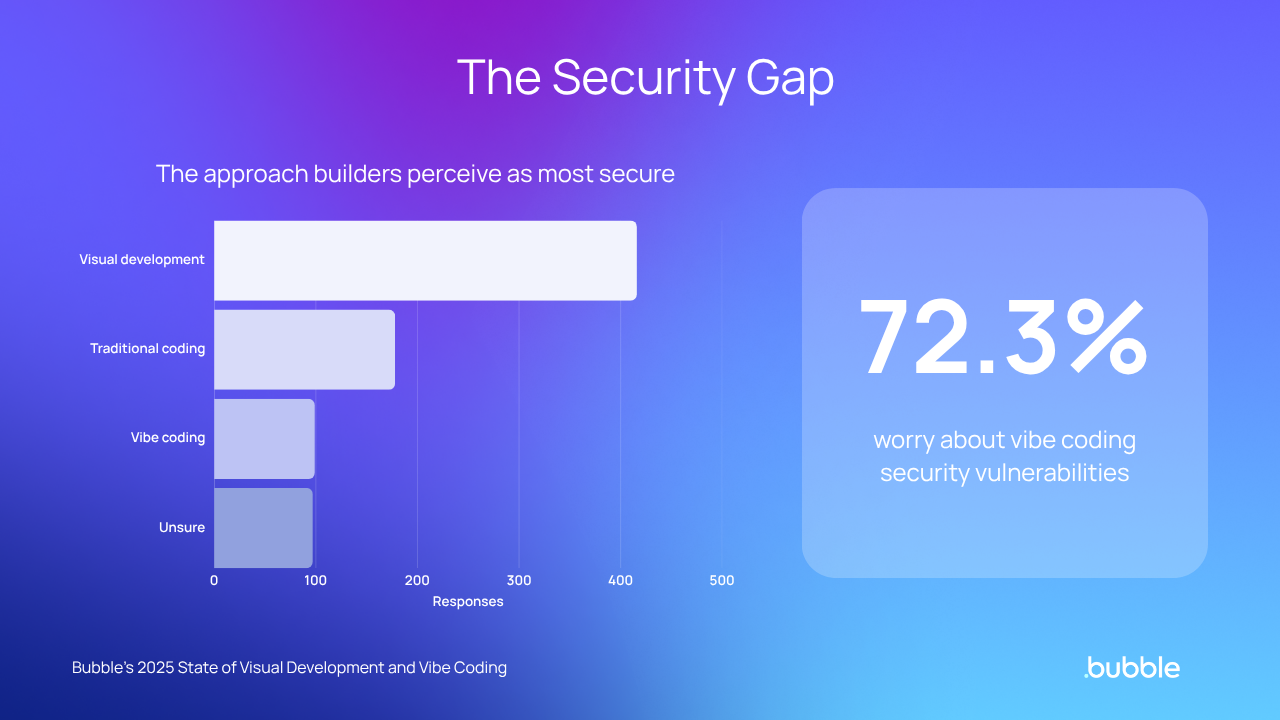
Security isn’t just about what the platform provides — it’s about what builders can understand, audit, and control. Visual development platforms show you exactly how data flows, where privacy rules apply, and how authentication works. With vibe-coded applications, you’re trusting AI-generated code you often can’t fully audit or understand.
Enterprise considerations matter here. SOC 2 Type II compliance requirements, audit trails and transparency, understanding exactly what was built, and the ability to verify security implementations all depend on visibility into your application’s logic.
You can’t secure what you can’t understand. The 72.3% of builders who worry about vibe coding security aren’t being paranoid — they’re being realistic about the challenges of deploying black-box AI-generated code in production environments.
Productivity and speed
Productivity gains with visual development proved substantial:
- 32.5% reported being 10X or more faster
- 24.8% reported 5–10X faster
- 20.1% reported 3–5X faster
- Combined, 77.4% report 3X or greater productivity gains
Productivity gains with vibe coding showed a different pattern:
- 23.5% reported being 10X or more faster
- 16.7% reported 5–10X faster
- 19.1% reported 3–5X faster
- Notably, 22% reported productivity about the same as traditional coding
The productivity paradox emerges clearly: Vibe coding promises instant apps, yet 22% report productivity about the same as traditional coding. Meanwhile, visual development — which has a learning curve — delivers 3 times or greater gains for 77.4% of builders.
The difference lies in how gains compound over time. Visual development’s productivity advantages increase as you build, iterate, and maintain applications. Vibe coding’s speed advantage disappears when you hit the debugging and customization phase — what we call “prompt purgatory.”
Who sees the biggest gains? Professional developers using visual development daily show the highest adoption rate at 77.5%, while mid-level technical users report the highest productivity gains with 35.6% experiencing 10 times or greater improvements. The pattern is clear: The more you build, the more value visual development delivers.
Serving different builder types
For non-technical users, we asked how well each approach serves their needs. Visual development received “very good” or “perfectly suited” ratings from 71.9%, compared to 44.2% for vibe coding.
For technical users, visual development earned “very good” or “perfectly suited” ratings from 74.8%, while vibe coding received such ratings from 59.5%.
The assumption is often that vibe coding helps non-technical builders while visual development serves technical users. The data shows visual development excels for both groups. The reason is straightforward: The challenge isn’t just getting started. It’s completing projects and maintaining them over time.
Cost savings and business impact
Cost savings with visual development compared to hiring engineers showed significant impact across the board:
- 27.4% saved $10,000–50,000 annually
- 21.7% saved $50,000–250,000 annually
- 15.9% saved under $10,000
- 8% saved $250,000 or more
- 2.6% saved $1 million or more
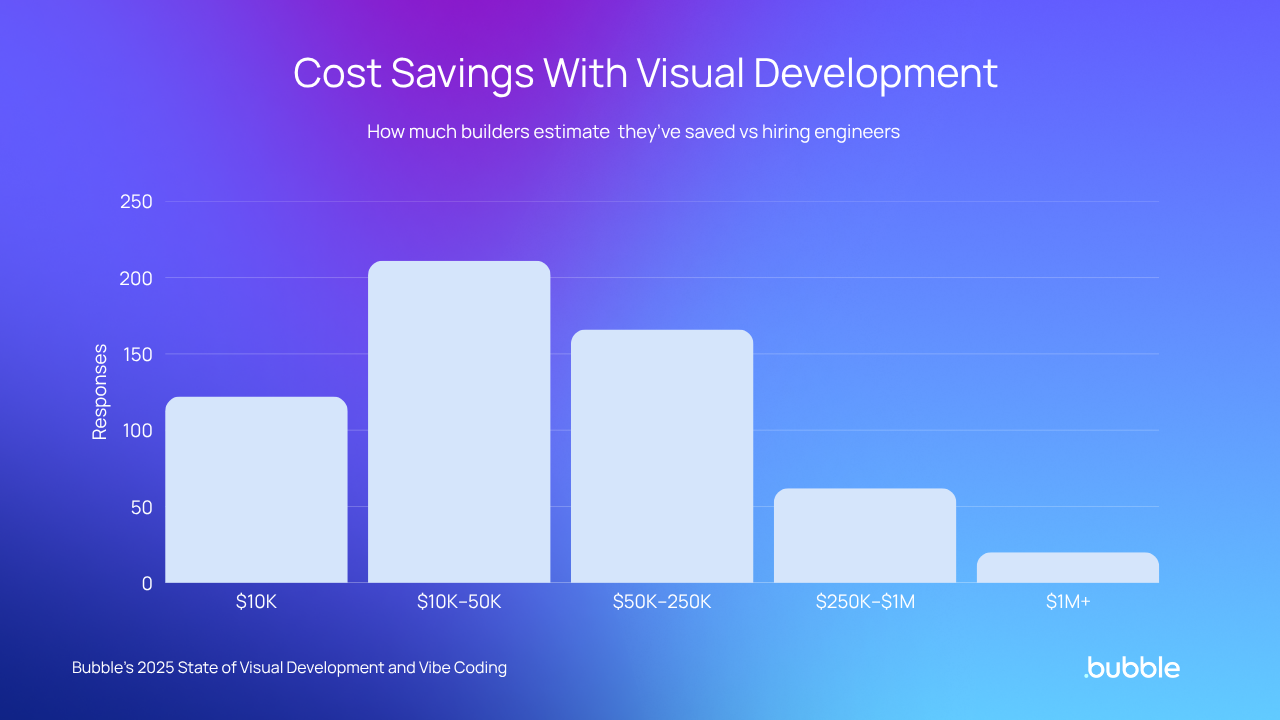
The headline number is striking: Nearly 50% of builders report saving up to $250,000 annually in development costs using visual development tools.
The reduced need to hire engineers tells a complementary story. 55.1% significantly reduced their hiring needs, while 29.9% somewhat reduced them. Only 14.4% saw no change, and a mere 0.6% actually increased hiring.
Cost savings go beyond subscription fees — they also include reducing or eliminating the need for engineering hires, accelerating time to market, and enabling faster iteration. When 84.9% report reducing their need to hire engineers, with 55.1% doing so significantly, that’s transformational for early-stage companies.
What each approach does well
Both technologies have roles to play in modern app development. Understanding where each excels helps builders make informed decisions about their toolkit.
Where vibe coding shines
According to users, vibe coding platforms excel particularly at rapid prototyping and iteration (61.2%), lowering barriers to entry for new developers (44.8%), and enabling non-technical founders to build products (44.4%).
The prototyping sweet spot is real. Vibe coding excels at getting to a working demo quickly. For validating ideas, testing concepts, or showing stakeholders a rough version, AI code generation offers impressive speed. The challenge emerges when you need to move from prototype to production.
Where do builders successfully use vibe coding? The use cases cluster around throwaway prototypes for concept testing, simple template-based applications, starting points that experienced developers can modify, and rapid exploration of design possibilities.
If you need a functional demo by tomorrow and don’t care about maintaining it long-term, vibe coding can deliver. The issues arise when that prototype needs to become a production application or when AI generates something 80% right that you need to debug and customize.
Where visual development dominates
According to users, visual development platforms excel across a broader range of capabilities. They lead in enabling non-technical founders to build real products (64.1%), lowering barriers to entry (58.4%), rapid prototyping and iteration (57.9%), and reducing time-to-market dramatically (52.4%). Additionally, 43.7% say visual development accelerates experienced developer workflows.
Visual development excels at everything vibe coding does — prototyping, accessibility, speed — while also delivering the control, transparency, and reliability needed for production applications. That’s why 86.7% would recommend it to new entrepreneurs, compared to 51.4% for vibe coding.
The complete package includes backend and database functionality built in, along with hosting and deployment infrastructure. Security and compliance capabilities come standard, as do team collaboration features and native mobile app development for iOS and Android. Most importantly, there’s a clear path from MVP to scale.
Visual development isn’t just faster at building — it’s better at everything that comes after: debugging, iterating, maintaining, and scaling your application over time.
The hybrid future
Looking ahead to the next 12 months, builders’ usage plans reveal clear momentum:
- 75.7% plan to increase visual development usage
- 50% plan to increase vibe coding usage
- 16.8% plan to increase traditional coding
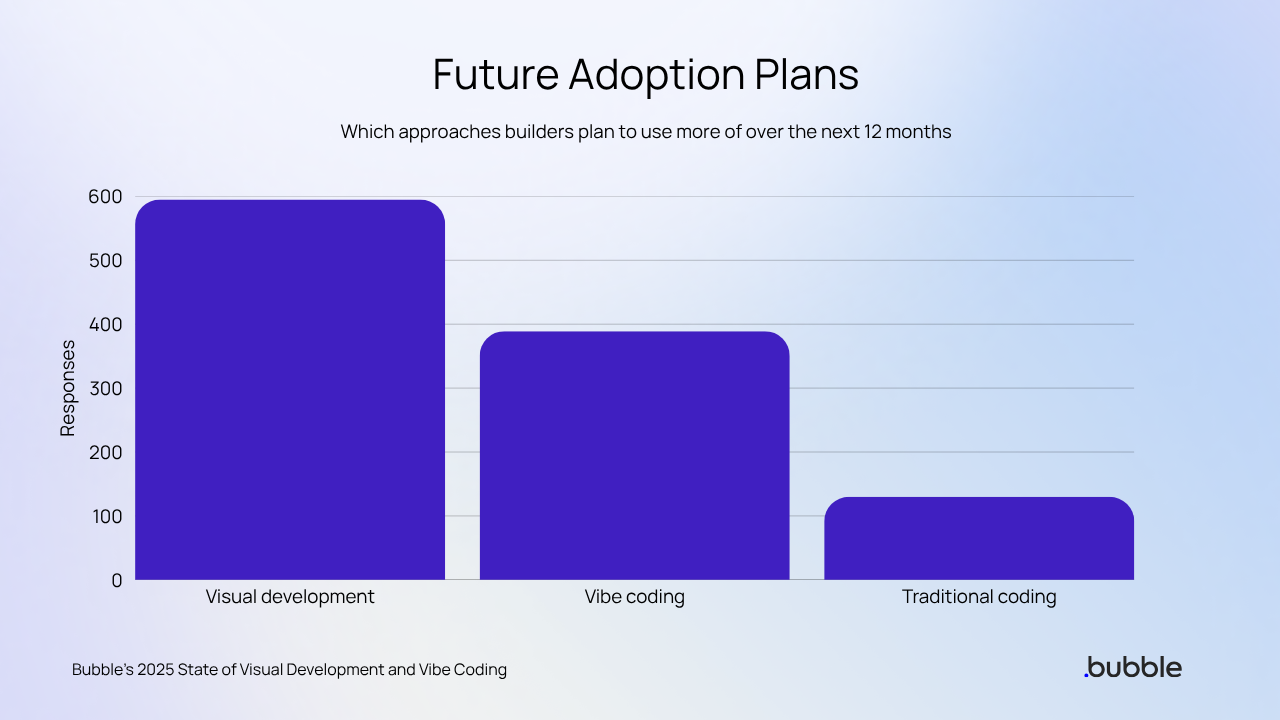
The future isn’t choosing between AI speed and visual control. It’s having both. Platforms that combine AI-powered generation with visual editing capabilities offer the best of both worlds: AI accelerates initial creation, while visual tools provide control for iteration and debugging.
This is exactly what Bubble has built: AI that generates working applications instantly, combined with visual editing that gives you complete control to refine, debug, and customize. You get the speed of vibe coding without the “prompt purgatory” that traps builders when AI hits its limits.
Recommendations: Choosing the right approach
Based on our research findings, here’s practical guidance for different scenarios.
Choose vibe coding when
Vibe coding makes sense when you’re building throwaway prototypes for concept validation or when you’re an experienced developer who can read and modify generated code. It works for creating simple, template-based applications and exploring design possibilities quickly. If your timeline is measured in hours rather than weeks and the project won’t require ongoing maintenance, vibe coding can deliver value.
Choose visual development when
Visual development is the better choice when building production applications for real users or when you’re a non-technical founder building a business. It excels at complex, custom applications requiring mission-critical reliability. If you’re building cross-platform applications spanning web and mobile, need team collaboration capabilities, face long-term maintenance and iteration requirements, care about security and compliance, or simply need to understand how your app works, visual development provides the necessary foundation.
Consider hybrid approaches when
Hybrid approaches make sense when you want AI acceleration for initial builds but need visual control for customization. They’re essential when production readiness is non-negotiable and when you’re building a business, not just a prototype.
The key questions to ask
Before choosing your development approach, consider these questions:
- Is this a prototype or a production application? If you’re building something users will depend on, you need more than rapid generation — you need the ability to maintain and iterate.
- Will you need to debug and customize beyond AI capabilities? AI is impressive, but it has limits. Can you take control when it falls short?
- Does your business depend on this working reliably? Mission-critical applications require transparency and control, not black-box AI decisions.
- Do you need to understand and audit how it works? Security, compliance, and maintenance all require visibility into your application’s logic.
- Will you need to maintain and iterate on this long-term? Early speed matters less than sustainable velocity over months and years.
The recommendation hierarchy
Based on our research, experienced builders’ recommendations paint a clear picture: 86.7% would recommend visual development to new entrepreneurs, rating it “absolutely” or “yes, in most cases.” Only 51.4% would recommend vibe coding, and usually with conditions like “only for prototyping” or “if you have coding experience.”
The gap reflects real-world experience: Getting started quickly matters less than finishing successfully. The builders who’ve tested both approaches know that production applications require more than impressive demos — they require control, transparency, and reliability.
Industry predictions and future outlook
The convergence prediction
The future of app development isn’t visual development or vibe coding or traditional coding — it’s a convergence of all three technologies deployed strategically.
In 2025, we expect AI features to become standard in visual development platforms. The distinction between “visual development” and “AI-powered visual development” will blur as every major platform integrates AI capabilities.
By 2025, a clear separation should emerge between “prototyping tools” and “production platforms.” Vibe coding tools will continue to improve at rapid generation, while visual development platforms will dominate production deployments.
Looking toward 2027, the terms “vibe coding” and “visual development” may blur as categories converge. The winners will be hybrid platforms that offer both AI-powered generation and visual editing — giving builders speed and control.
What must evolve
For vibe coding tools to compete in production environments, they need transparency into generated code that shows builders what was created. Built-in debugging capabilities must help when AI makes mistakes. Visual editing after AI generation should enable customization without re-prompting. Better error handling and explanation needs to move beyond cryptic failures. And production infrastructure including hosting, scaling, security, and database management must come standard.
For visual development to maintain its lead, platforms need deeper AI integration throughout, not just for initial generation. Expanded mobile capabilities should build on native iOS and Android foundations. More sophisticated automation should help AI understand specific app needs. Enhanced enterprise features must address advanced security, compliance, and team management. Most critically, platforms must continue focusing on transparency and control, never sacrificing visibility for convenience.
Market predictions
Based on survey data and industry trends, several predictions emerge. Visual development usage will grow faster than vibe coding, with 75.7% versus 50% planning to increase usage. The gap reveals that builders who’ve tested both approaches see clearer paths to success with visual development.
Security and compliance concerns will limit vibe coding production adoption. Until vibe coding tools solve the black-box problem — helping builders understand and audit what was generated — they’ll struggle to gain confidence for mission-critical use.
Professional developers will increasingly adopt visual development as a primary tool. The 77.5% of professional developers already using visual development daily shows this isn’t a trend toward “dumbing down” development — it’s a shift toward working at higher levels of abstraction.
Non-technical founders will continue choosing proven approaches over experimental ones. When your business depends on your app working reliably, the appeal of cutting-edge AI matters less than the reality of production-ready tools.
The bigger picture
Software development is becoming more accessible, but not by eliminating understanding — by making understanding easier. Visual development succeeds because it helps builders comprehend what they’re creating. Vibe coding struggles because it creates black boxes that are fast to generate but hard to maintain.
The future belongs to tools that accelerate without obscuring, that generate without mystifying, and that help builders ship production applications — not just impressive demos.
Advice for the industry
For tool builders, the path forward requires focusing on production readiness rather than just generation speed. Prioritize transparency and control over clever automation. Build complete platforms, not just code generators. Invest in security and compliance from day one. Remember that early speed matters less than sustainable velocity.
For builders choosing tools, make decisions based on your end goal rather than marketing hype. Test tools with real projects before committing. Prioritize platforms with production track records. Remember that starting fast matters less than finishing successfully. Don’t confuse impressive demos with sustainable development practices.
For investors and analysts evaluating this space, look beyond demo day impressions to production metrics. Evaluate platforms on builder success rates, not just user counts. Consider maintenance and scalability, not just initial build speed. Ask: “Would I trust this platform to support my business?” Recognize that accessibility and power aren’t mutually exclusive.
Methodology appendix
Survey design
We collected 793 total responses between September and October 2025 through email surveys sent to Bubble community segments. These included all active Bubble users in the last 30 days (excluding new signups), Bubble users who indicated interest in hiring agencies in the last 180 days, agency seat holders building professionally for others, users who generated apps with AI, and long-time users who’d been registered for over a year but hadn’t returned in the last six months.
The survey used multiple question types, including multiple-choice, rating scales from 1–5, and open-ended responses. Survey focus areas included platform usage patterns, productivity metrics, confidence levels, security perceptions, business impact, and future plans.
Respondent breakdown
Professional roles distributed as founders (36.4%), developers (31%), business owners (10.9%), freelancers or consultants (8.7%), and other roles (12%).
Technical backgrounds spanned professional developers (22.7%), some coding experience (23.9%), non-technical business users (22%), technical background but not primary role (17.1%), and complete beginners (14.3%).
Organization sizes included solo founders or freelancers (53.2%), startups and small businesses with 2–200 employees (42.5%), and mid-size and larger organizations (less than 5%).
Experience levels with these platforms ranged from less than six months (25.1%), to six to twelve months (17.6%), one to two years (18.8%), two to five years (24.9%), and more than five years (13.6%).
Data analysis
Surveys with incomplete responses to core questions were excluded from relevant analysis. Open-ended responses were coded for common themes. All percentages represent the proportion of respondents who selected each option out of total respondents who answered that specific question.
Limitations and considerations
This research represents views of current and former Bubble users who have real app-building experience, comparisons from builders who've explored multiple approaches (with 25.6% actively using vibe coding tools), success rates and confidence levels from production experience, and business impact data from builders who've shipped real applications.
It does not represent a neutral industry-wide perspective (we surveyed our community), views of pure vibe coding users who’ve never tried visual development, comprehensive market share data across all platforms, or experiences of builders who only use traditional coding.
Why does this approach still provide value? Our community represents a unique perspective: experienced builders who’ve had the freedom to explore any tool they wanted. Many have tried vibe coding alongside visual development. Their opinions are informed by real comparison, not theory.
When builders who could choose any approach tell us what actually works for production applications, that’s valuable insight — even if it comes from our community rather than a neutral third party. The fact that 25.6% actively use vibe coding tools demonstrates this isn’t a captive audience simply defending their current choice.
How to cite this report
Bubble (2025). Beyond the Hype: The 2025 State of Visual Development and Vibe Coding. Retrieved from https://bubble.io/blog/2025-state-of-visual-development-ai-app-building
About Bubble
Bubble is the only app development platform that lets you switch seamlessly between AI prompting and visual editing to go beyond prototypes and launch real apps without limits. You can generate and edit working web and mobile apps quickly with AI, and then use Bubble’s visual editor to fine-tune every detail, from the design to the backend and programming logic. You’re never stuck, even if AI hits its limits — and no code is required, ever. Everything you need comes built in: enterprise-grade hosting, security, database management, and automatic scaling that grows with your business. From first-time founders to Fortune 500 companies, nearly 6 million builders trust Bubble to turn their ideas into reality faster and more affordably than traditional development.
This report reflects our commitment to transparency about what works in modern app development. While we’re proud that visual development — and Bubble specifically — performs well in these findings, our goal is to help builders make informed decisions about the best tools for their needs.
Build for as long as you want on the Free plan. Only upgrade when you're ready to launch.
Join Bubble